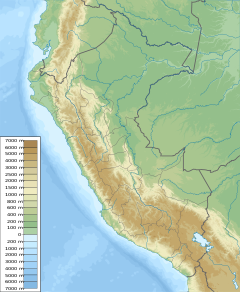| Osmore River Moquegua River, Rio Coscori, Rio Tumilaca, Ilo River | |
|---|---|
 Moquegua (Osmore) River Valley | |
| Location | |
| Country | Peru |
| State | Moquegua Region |
| Region | South America |
| Physical characteristics | |
| Source | Chuquiananta and Arundane Mountains |
| • location | Sierra, Peru |
| • coordinates | 16°52′00″S 70°26′00″W / 16.86667°S 70.43333°W |
| • elevation | 5,100 m (16,700 ft) |
| Mouth | Pacific Ocean |
• location | Ilo, Coastal Pacific Ocean, Peru |
• coordinates | 17°43′0″S 71°20′0″W / 17.71667°S 71.33333°W |
• elevation | 0 m (0 ft)Pacific Ocean |
| Length | 480 km (300 mi)approx. |
| Basin size | 3,480 km2 (1,340 sq mi)approx. |
| Basin features | |
| River system | Moquegua River |
Osmore River (also Moquegua, Ilo, or Tumilaca) system flows northeast to southwest in the Moquegua Region of southern coastal Peru. The river has its origin in the snow peaks of the Chuqi Ananta and Arundane mountains, at an elevation of 5,100 metres (16,700 ft) above sea level. It changes names as it descends from the Andes: From its origin it is called the Moquegua, then Osmore in the middle valley as Rio Coscori and Rio Tumilaca including where the river disappears into subterranean channels, and further down in the lower reaches as Rio Ilo.[1]
An initial reconnaissance of the archaeological treasures of the valley carried out in the 1980s revealed more than 500 archeological sites dated from 10,000 years of human occupation.[2] The Asana archaeological site, occupied over a period of 8,000 years,[3] is located by the Asana River, a tributary of the Osmore.[4]
There are also Wari culture sites, and the Tiwanaku culture sites in the area; this is where these two cultures came in contact.
- ^ Rice, Don S.; Stanish, Charles; Scarr, Phillip R. (1989). "Ecology, Settlement and History in the Osmore Drainage, Perú". BAR International Series 545(ii). University of California Los Angeles. Archived from the original on 4 July 2013.
- ^ "Field Museum of Natural History Bulletin". Archive organization. Retrieved 6 July 2013.
- ^ Kennett & Winterhalder 2006, p. 180.
- ^ Kennett & Winterhalder 2006, p. 172.
